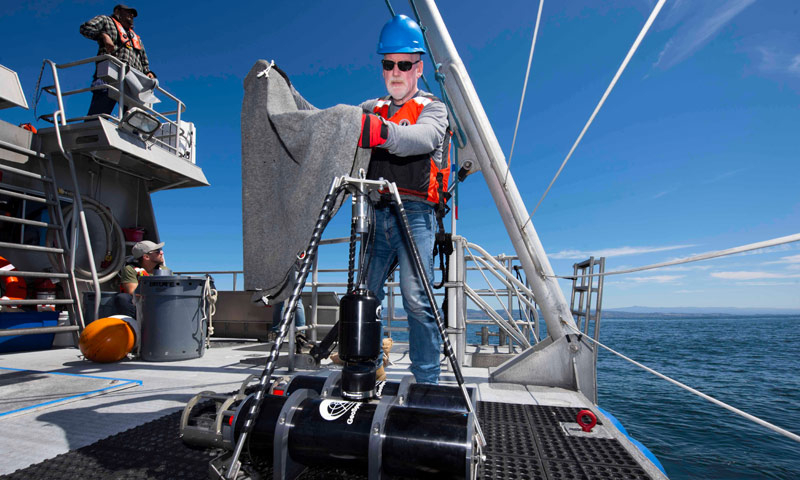It was a surprisingly sunny day when the small group of researchers equipped the R/V Fulmar for their first of five days data collection trip off the coast of Santa Cruz in the Monterey Bay. Their goal was to use vector sensors, passive acoustic technology that detects particle motion and pressure changes, to collect data for several projects. The trip was run by Dr. Kevin Smith, a Professor of Physics at the Naval Postgraduate School (NPS) and the Chair of the NPS Undersea Warfare Academic Group, and Dr. Paul Leary, a Research Assistant Professor of Physics at NPS. Together they run the NPS Undersea Sensing Systems Lab.
Understanding marine acoustics is important for both national defense and environmental purposes. Vector sensors can help detect acoustic signals, and provide estimates of direction to adversarial marine vessels, merchant ships, or marine mammals. Researchers can use the data collected to learn more about sound characteristics in different parts of the ocean, and make determinations about the local underwater propagation environment. This understanding can help unmanned underwater vehicles (UUVs) better navigate and communicate with each other, provides data to improve predictions of operational performance, and aids in marine mammal studies by keeping track of different individual animals via their sounds. Better understanding these big picture items is the focus of Smith’s efforts.
“The technologies, the sensors we use, and the processes we employ for tracking marine mammals or merchant vessels is the same kind of processing we use to track other targets of interest to the Navy,” Smith says. “So we are building up our skills to see how far we can track something, how accurate we can track something, how quietly a target can be that we can still track.”
In other words: “Anything you can use to track a submarine, you can use to track a whale,” says Anu Kumar, director of the Office of Naval Research (ONR)’s Living Marine Resources (LMR) program. ONR is one of the sponsors of this research, along with the NPS Naval Research Program (NRP), and the Los Alamos National Laboratory.
Kumar joined the team on their first day out to observe and assist the researchers in deploying vector sensors and retrieving them for data collection. The team included an NPS summer intern, Navy MIDN 1/C Anne (Bonnie) Tom from the U.S. Naval Academy, PhD student Nick Durofchalk from Georgia Tech, and international PhD student and Brazilian officer Alexandre Guarino from NPS.
Guarino is studying Engineering Acoustics at NPS. His thesis relies on this field research as it looks to determine acoustic properties of the sea floor using various signals collected throughout the test. This process is known as geoacoustic inversion.
“I feel very happy working with these very advanced systems,” Guarino says. This will be his second research project focusing on marine acoustics, but it is his first time working with vector sensors, where previously he worked with pressure sensors. This means he has more data to work with, and new features in the acoustic field to explore.
The trip involved deploying two vector sensor systems at multiple locations along the Santa Cruz shelf to collect data for his work, one of which was provided by the Naval Undersea Warfare Center (NUWC) in Newport, R.I. The team also collected data from a drifting buoy equipped with vector sensors supplied by and with help from an engineer at the NUWC in Keyport, Wash.
“When we do tests like these we are often trying to collaborate with and help out as many people as we possibly can,” Leary says. “We like to construct experiments that touch on several concepts that have important questions around them as far as we can manage with the timeframe we have on the boat.”
The team conducted experiments to try to answer questions from Smith, Leary, Guarino, Durofchalk, and several other researchers in and out of NPS. These questions range from purely theoretical to mechanical.
For example, Smith and Leary wanted to see what the data can tell them about the sensors’ abilities. Part of the trip involved deploying two sensors 10 km apart along the Santa Cruz shelf to see if the sensors could localize signals of interest, such as ships and whales, by both picking up the same signal at once. The team generated signals made by imploding lightbulbs in a device designed by Leary, who’s the primary engineer of the team, to test how well the sensors could localize the same sound. This signal is also being used to understand the environment between the source and sensor.
Leary’s job was to make sure the data collected was as clear and useful as possible. He works to make the data processing part more efficient by creating pipelines to feed the data into, which reflect data processing as performed on autonomous systems. For example, he would like to get a computer to recognize certain sounds as ships or whales, or make it possible for a researcher to efficiently request processed data products for a period of time from a common database.
Now that it’s the end of the two weeks of data collection, the team is ready to sink their teeth into the data, hoping to advance the Navy’s utilization of vector sensors as a means to better understand the environment submarines operate in, and to protect the fleet from possible adversarial underwater advances.


